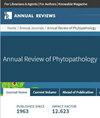气候变化对病原体出现的影响:人工智能翻译大数据以缓解。
IF 11.9
1区 农林科学
Q1 PLANT SCIENCES
引用次数: 9
摘要
植物病理学已经开发了一系列用于改善植物疾病管理的概念和工具,包括用于理解和应对气候变化新风险的模型。这些工具中的大多数都可以利用人工智能(AI)的新进展进行改进,例如将大量数据集集成到预测模型中的机器学习。有可能开发自动化的风险分析,提醒决策者,从农场管理者到国家植物保护组织,可能需要采取行动,并为有针对性的应对措施提供决策支持。我们回顾了机器学习在植物病理学中的应用,并为下一步在数字农业中充分利用这些工具综合了想法。全球项目,如拟议的全球植物疾病监测系统,将通过整合广泛的新数据来加强,包括来自遥感器等工具的数据,这些工具用于评估植物疾病的风险。人工智能在加强全球能力建设方面也有着令人兴奋的潜力,从用于疾病诊断的图像分析和农民手机上的相关管理建议,到针对当前风险的管理需求实时定制的植物病理学家未来培训方法。在整合数据和模型方面的国际合作将有助于制定应对气候变化新挑战的最有效对策。《植物病理学年度评论》第60卷预计最终在线出版日期为2022年8月。请参阅http://www.annualreviews.org/page/journal/pubdates用于修订估算。本文章由计算机程序翻译,如有差异,请以英文原文为准。
Climate Change Effects on Pathogen Emergence: Artificial Intelligence to Translate Big Data for Mitigation.
Plant pathology has developed a wide range of concepts and tools for improving plant disease management, including models for understanding and responding to new risks from climate change. Most of these tools can be improved using new advances in artificial intelligence (AI), such as machine learning to integrate massive data sets in predictive models. There is the potential to develop automated analyses of risk that alert decision-makers, from farm managers to national plant protection organizations, to the likely need for action and provide decision support for targeting responses. We review machine-learning applications in plant pathology and synthesize ideas for the next steps to make the most of these tools in digital agriculture. Global projects, such as the proposed global surveillance system for plant disease, will be strengthened by the integration of the wide range of new data, including data from tools like remote sensors, that are used to evaluate the risk of plant disease. There is exciting potential for the use of AI to strengthen global capacity building as well, from image analysis for disease diagnostics and associated management recommendations on farmers' phones to future training methodologies for plant pathologists that are customized in real-time for management needs in response to the current risks. International cooperation in integrating data and models will help develop the most effective responses to new challenges from climate change. Expected final online publication date for the Annual Review of Phytopathology, Volume 60 is August 2022. Please see http://www.annualreviews.org/page/journal/pubdates for revised estimates.
求助全文
通过发布文献求助,成功后即可免费获取论文全文。
去求助
来源期刊

Annual review of phytopathology
生物-植物科学
CiteScore
16.60
自引率
1.00%
发文量
19
期刊介绍:
The Annual Review of Phytopathology, established in 1963, covers major advancements in plant pathology, including plant disease diagnosis, pathogens, host-pathogen Interactions, epidemiology and ecology, breeding for resistance and plant disease management, and includes a special section on the development of concepts. The journal is now open access through Annual Reviews' Subscribe to Open program, with articles published under a CC BY license.
 求助内容:
求助内容: 应助结果提醒方式:
应助结果提醒方式:


